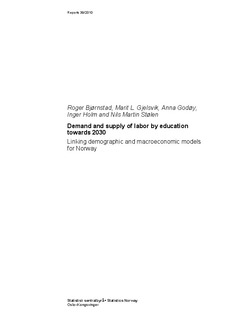| dc.contributor.author | Bjørnstad, Roger | |
| dc.contributor.author | Gjelsvik, Marit Linnea | |
| dc.contributor.author | Godøy, Anna Aasen | |
| dc.contributor.author | Holm, Inger | |
| dc.contributor.author | Stølen, Nils Martin | |
| dc.date.accessioned | 2012-02-06T22:26:57Z | |
| dc.date.available | 2012-02-06T22:26:57Z | |
| dc.date.issued | 2010 | |
| dc.identifier.issn | 1892-7513 | |
| dc.identifier.uri | http://hdl.handle.net/11250/181155 | |
| dc.description.abstract | Because of globalization and technological progress, most OECD-countries have seen
a considerable growth in the demand for labor with higher skills and educational
levels the past decades. In many countries, supply has not grown correspondingly.
This has resulted in increasing differences either in unemployment or in wages
between high and low skilled workers. In Norway, labor supply has followed demand
more closely, and unemployment and wages have stayed relatively equal. The past
trends in the educational upgrading will probably continue, and further stability in the
labor market requires that labor demand and supply matches also in the future. Both
for future students, who must decide on education, and the authorities, who must plan
the educational capacity, industrial development and welfare reforms etc., projections
on demand and supply of labor by education is useful.
In Norway, Statistics Norway has produced such projections since 1993, and in this
report, we present new projections towards 2030. A central tool in projecting the
demand for labor is the macroeconomic model MODAG, which has a core of inputoutput
relations to capture the interaction between the different industries. Because
demand for labor is projected in each industry, the use of MODAG also leaves room
to analyze the effects of inter- and intra-industry changes in demand for labor by
education. In a macroeconomic model, labor as an input factor cannot be too
heterogeneous with respect to education. MODAG gives projections for demand and
supply of labor by education within only five aggregated educational levels/groups.
Hence, a module translating demand for labor by industry into demand for labor by
education at a detailed level is linked to MODAG. | no_NO |
| dc.description.sponsorship | This report has been financed by Ministry of Education and Research, Ministry of
Labour, Ministry of Trade and Industry and the Labour and Welfare Service. | no_NO |
| dc.language.iso | eng | no_NO |
| dc.publisher | Statistisk sentralbyrå | no_NO |
| dc.relation.ispartofseries | Rapporter;2010/39 | |
| dc.subject | Labor supply | no_NO |
| dc.subject | Labour demand | no_NO |
| dc.subject | Education | no_NO |
| dc.subject | MODAG (macroeconomic model) | no_NO |
| dc.subject | MOSART (microsimulation model) | no_NO |
| dc.subject | Norway | no_NO |
| dc.subject | Educational level | no_NO |
| dc.subject | Arbeidskraft | no_NO |
| dc.subject | Etterspørsel | no_NO |
| dc.title | Demand and supply of labor by education towards 2030. Linking demographic and macroeconomic models for Norway | no_NO |
| dc.type | Report | no_NO |
| dc.subject.nsi | VDP::Social science: 200::Economics: 210::Economics: 212 | no_NO |
| dc.source.pagenumber | 44 s. | no_NO |
